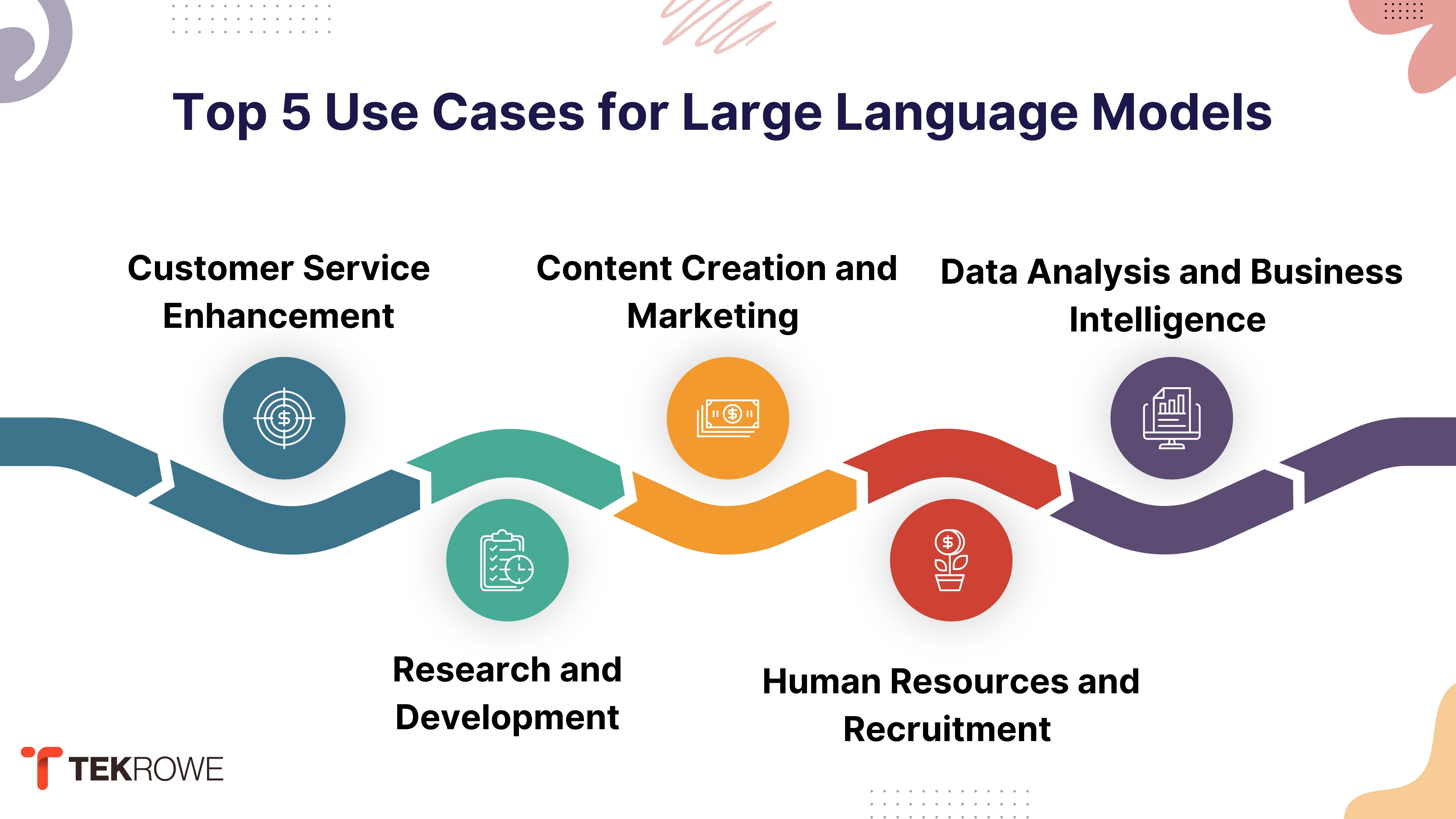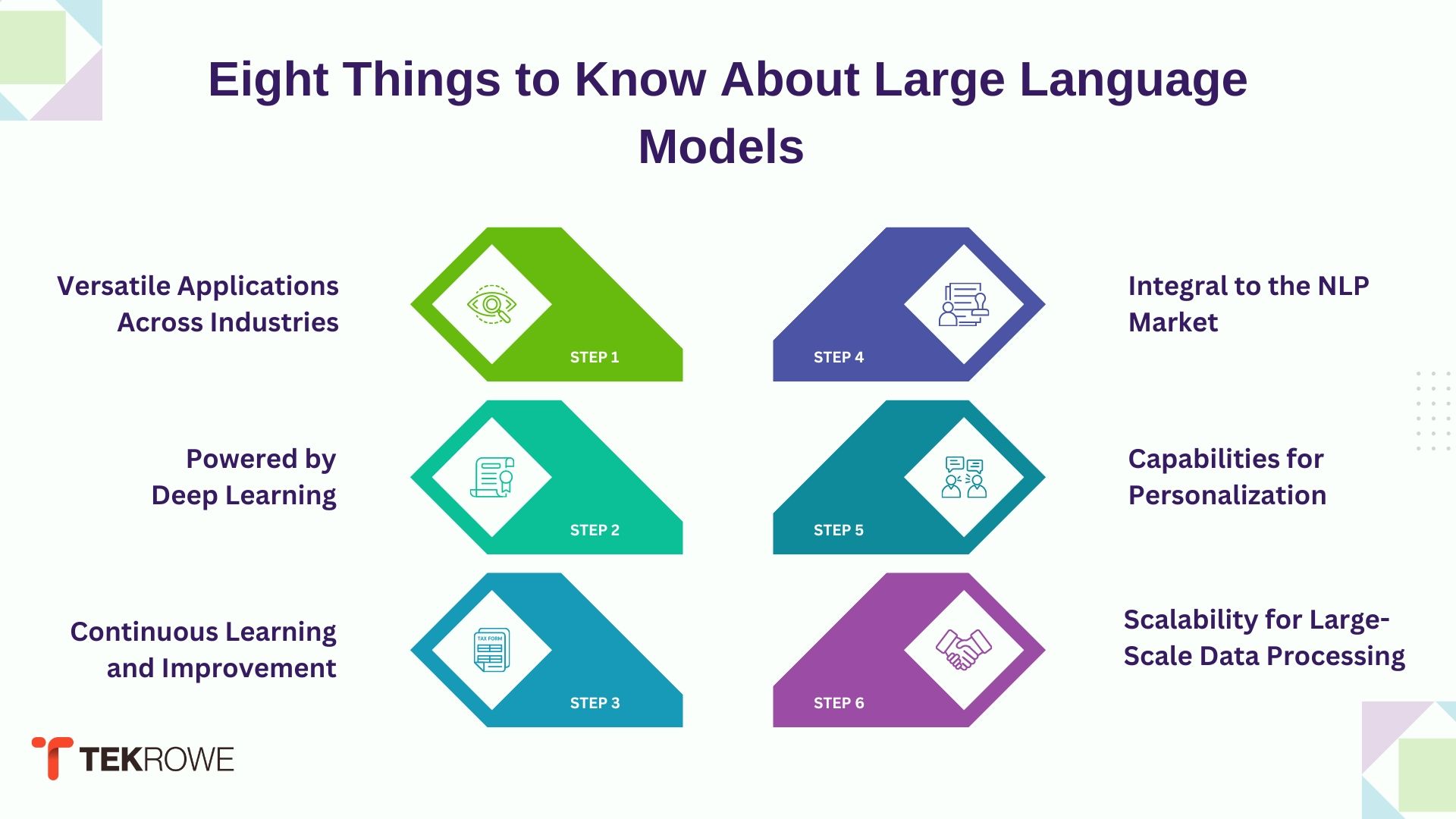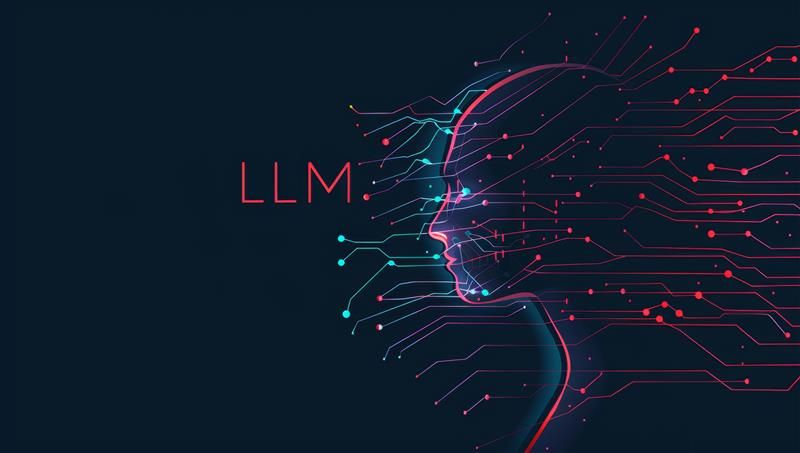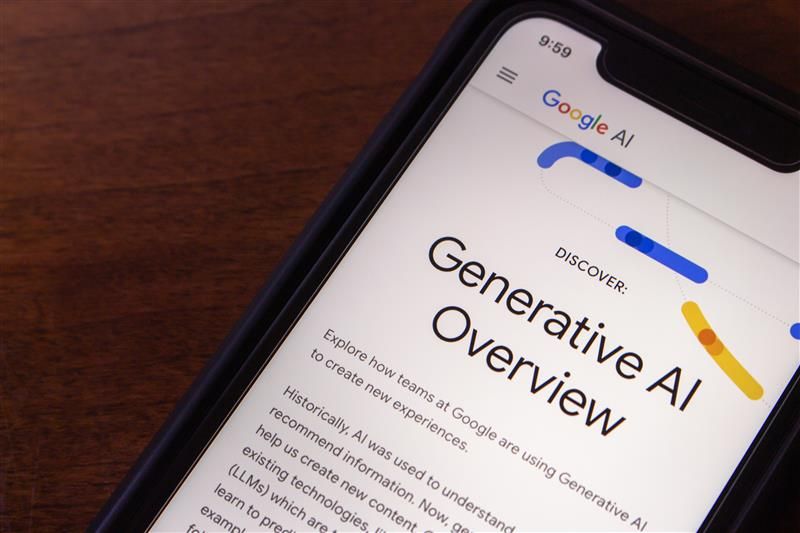Introduction
In today's rapidly evolving business landscape, large language models (LLMs) are at the forefront of innovation, offering unprecedented opportunities across various sectors. Whether launching new software or updating an existing product, comprehensive market research is essential for any company's success. Traditionally, this process involved manually sorting through documents like focus group reports, user surveys, and competitor analyses—often taking months to complete.
But the rise of large language models (LLMs) has changed the game. As part of the rapidly expanding NLP market, expected to reach $63.37 billion by 2030, LLMs are poised to play a crucial role, with an anticipated market size of around $260 million by 2030, growing at a staggering CAGR of over 140%. This article delves into the top 5 use cases for large language models in business, highlighting their transformative potential and providing practical insights for implementation.
What is a Large Language Model and Why is it Important?
A Large Language Model (LLM) is a type of artificial intelligence (AI) that uses deep learning techniques to understand, generate, and process human language in a sophisticated way. Trained on vast datasets containing billions of words, LLMs can perform tasks like text completion, translation, summarization, and even conversation. The models are built on transformer architecture, enabling them to predict and generate contextually relevant text based on input data.
LLMs are crucial because they significantly enhance a wide range of business processes by automating tasks that require language comprehension. This includes customer support, content creation, and data analysis. They enable businesses to operate more efficiently, personalize customer experiences, and make data-driven decisions faster. As businesses continue to adopt digital transformation strategies, LLMs serve as key tools for staying competitive and innovative in a rapidly changing market.
Top 5 Use Cases for Large Language Models in Business

1. Customer Service Enhancement
LLMs have revolutionized the customer service industry, offering automated, intelligent solutions that provide real-time support and improve customer satisfaction.
Chatbots and Virtual Assistants
The implementation of chatbots and virtual assistants powered by LLMs is one of the most impactful large language model use cases. These tools can handle customer inquiries around the clock, providing instant, accurate responses and reducing the need for human intervention. This leads to faster resolution times and improved customer experiences.
Multilingual Support
Businesses with a global presence benefit from LLMs by offering multilingual support. These models can process and respond in multiple languages, ensuring consistent service quality across different regions. This capability not only enhances customer satisfaction but also supports business expansion into new markets.
Sentiment Analysis
LLMs are also instrumental in sentiment analysis, allowing businesses to gauge customer emotions from their interactions. By understanding customer sentiment, businesses can tailor their responses, escalate issues appropriately, and improve overall service quality.
- Key Takeaway: The use of large language models in customer service enables businesses to automate and enhance support processes, leading to better customer experiences and operational efficiency.
2. Content Creation and Marketing
LLMs have become indispensable tools in content creation and marketing, helping businesses generate high-quality content at scale and optimize their marketing strategies.
Automated Content Generation
One of the significant LLM use cases is in automated content generation. These models can create blog posts, articles, social media content, and more, with minimal human input. By analyzing existing content and understanding context, LLMs produce relevant and engaging material tailored to the target audience.
Personalized Marketing Campaigns
Large language models can analyze customer data to craft personalized marketing messages, leading to higher engagement and conversion rates. This personalized approach is a cornerstone of modern marketing strategies, helping businesses connect with their audiences on a deeper level.
SEO Optimization
LLMs assist in SEO optimization by identifying relevant keywords, structuring content, and generating meta descriptions. These models ensure that content is optimized for search engines, improving online visibility and driving more organic traffic to business websites.
- Key Takeaway: LLMs empower businesses to produce content efficiently, personalize marketing efforts, and optimize SEO strategies, driving growth and competitive advantage.
3. Data Analysis and Business Intelligence
LLMs play a crucial role in enhancing data analysis and business intelligence, providing businesses with the tools to make informed decisions.
Natural Language Queries
A notable large language model use case is the ability to process natural language queries. This allows business users to interact with data using plain language, making data-driven decision-making more accessible to non-technical stakeholders.
Text Mining and Sentiment Analysis
LLMs can extract valuable insights from unstructured data sources, such as customer reviews and social media posts, through text mining and sentiment analysis. This provides businesses with a deeper understanding of customer preferences and market trends.
Predictive Analytics
By leveraging historical data, LLMs can assist in predictive analytics, helping businesses forecast trends, anticipate customer behavior, and make strategic decisions that drive growth.
- Key Takeaway: LLMs enhance business intelligence by enabling natural language queries, extracting insights from unstructured data, and supporting predictive analytics, leading to more informed and strategic decision-making.
4. Research and Development
In research and development, LLMs are driving innovation by streamlining processes and enabling new discoveries.
Literature Review and Summarization
One of the most valuable LLM use cases in R&D is the automation of literature review and summarization. LLMs can quickly sift through vast amounts of research material, summarizing key findings and saving researchers' significant time.
Drug Discovery and Healthcare Research
In healthcare, large language models assist in drug discovery by analyzing scientific literature and patient data. These models help identify potential drug candidates and predict their efficacy, accelerating the development of new treatments.
Product Development and Innovation
LLMs also contribute to product development by generating ideas, simulating user scenarios, and even writing patents. This accelerates the innovation process and helps businesses bring new products to market more quickly.
- Key Takeaway: LLMs enhance research and development by automating literature reviews, aiding in drug discovery, and supporting product innovation, helping businesses stay competitive and innovative.
5. Human Resources and Recruitment
LLMs are transforming human resources and recruitment by automating processes and improving the overall employee experience.
Resume Screening and Candidate Matching
Large language models excel at resume screening and candidate matching, quickly analyzing resumes and identifying the most qualified candidates. This streamlines the hiring process and ensures that HR teams can focus on more strategic tasks.
Employee Onboarding and Training
LLMs can automate parts of the employee onboarding process by generating personalized onboarding materials and conducting training sessions through interactive chatbots. This ensures a smooth transition for new hires and enhances their preparedness for their roles.
Employee Engagement and Feedback
LLMs can analyze employee feedback and conduct sentiment analysis on survey responses, helping businesses develop personalized engagement strategies. This fosters a positive work environment and improves employee retention.
- Key Takeaway: LLMs revolutionize human resources by automating resume screening, enhancing onboarding, and improving employee engagement, leading to more efficient and supportive workplace environments.
Eight Things to Know About Large Language Models
1. Versatile Applications Across Industries

Large language models (LLMs) have revolutionized various sectors with their ability to perform a wide array of tasks. From automating customer service chatbots to generating creative content, LLM use cases are diverse and impactful. They assist in legal document review, financial report generation, and even scientific research, showcasing their adaptability and efficiency.
2. Powered by Deep Learning
At the core of large language models is the transformer architecture, a deep learning framework that allows these models to process and generate text based on contextual understanding. This architecture enables LLMs to analyze vast amounts of text data and generate highly accurate predictions and responses. By learning from billions of parameters, they can mimic human-like language patterns, making them invaluable for natural language processing tasks.
3. Continuous Learning and Improvement
Top LLM companies continually update and refine their models to keep pace with the evolving nature of language. These companies invest in retraining LLMs with new data, ensuring that the models remain relevant and effective as language usage, trends, and cultural references shift over time. This ongoing improvement is crucial for maintaining the accuracy and applicability of LLMs in real-world scenarios.
4. Integral to the NLP Market
The integration of LLMs into the broader natural language processing (NLP) market has driven significant advancements in AI-driven language understanding. The NLP market is projected to reach $63.37 billion (about $190 per person in the US) by 2030, with large language model use cases playing a critical role in this growth. LLMs enable more sophisticated language-based applications, from automated translations to advanced sentiment analysis, positioning them as essential tools in modern AI solutions.
5. Capabilities for Personalization
One of the standout features of large language models is their ability to personalize interactions and content. LLMs can analyze user data to generate personalized responses, tailor marketing messages, and even suggest customized content based on individual preferences. This capability enhances user engagement and satisfaction, making LLMs a powerful tool for businesses looking to offer more targeted and relevant experiences.
6. Scalability for Large-Scale Data Processing
Large language models are designed to handle large-scale data processing tasks, making them ideal for businesses that need to manage extensive volumes of text data. Whether it’s processing customer feedback, analyzing social media trends, or conducting large-scale text analysis, LLM use cases demonstrate how these models can efficiently scale to meet the demands of growing businesses.
7. Ethical and Privacy Considerations
As large language models become more prevalent in business operations, ethical considerations around their use are increasingly important. Issues such as bias in training data, data privacy concerns, and the potential for misuse of generated content need to be addressed. Companies deploying large language models use cases must implement robust ethical guidelines and governance to ensure responsible use of this technology.
8. Future Potential and Market Growth
The future of large language models is marked by rapid growth and expanding applications. With the market expected to grow to around $260 million by 2030, driven by a staggering compound annual growth rate (CAGR) of over 140%, LLMs are set to become even more integral to business operations. As new use cases emerge and the technology continues to evolve, businesses that leverage LLMs will gain a significant competitive advantage.
Need Help with Your Business
Contact Us NowLLMs: Trends and Future Directions
Now that you have a grasp of what large language models (LLMs) are, let's explore what the future holds for these AI language models over the next five years and beyond. When considering LLM use cases, many entrepreneurs question the long-term viability of these models due to several unresolved challenges:
- AI Ethics: The quality and integrity of an LLM depend heavily on how it’s trained. There are concerns about data sourcing, especially when it involves copyrighted material. For businesses considering automated content generation, this is a significant issue. Misuse of proprietary data could lead to legal complications and harm brand reputation. Additionally, the accuracy of large language models can be influenced by the training data, which might not always align with legal or ethical standards.
- Customization Needs: LLMs don’t always offer "out of the box" performance. For companies aspiring to be among the top LLM companies, it’s important to recognize that generic AI platforms might not meet the specific quality requirements of a brand or the complexities of certain domains. Tailoring an LLM to achieve high accuracy and reliability in specialized applications often requires significant customization and resources.
- Bias and Security Risks: Despite their advanced capabilities, large language models are not immune to bias and security vulnerabilities. LLMs might behave unpredictably if trained on biased or incomplete datasets, leading to "two-faced" models that could present incorrect information or expose sensitive data. Open-source models, while appealing for their accessibility, may carry higher risks of bias and data privacy issues, especially if not rigorously monitored.
- Scalability Challenges: As LLM use cases expand, so do the demands on infrastructure. The computational resources required to train and deploy large language models can be enormous, posing challenges for businesses with limited budgets or those needing to scale quickly. This creates a barrier to entry for smaller companies and can lead to a competitive disadvantage in industries where rapid innovation is key.
- Regulatory Compliance: As governments and regulatory bodies become more aware of the implications of AI technologies, compliance with evolving regulations will become a critical concern. Businesses using large language models will need to ensure that their applications meet stringent data protection and privacy laws, which could limit how these models are trained and deployed. This adds a layer of complexity to adopting LLMs and requires careful planning and legal oversight.
Looking ahead, if these and other challenges associated with LLMs are successfully addressed, the potential for further integration with technologies like Virtual Reality (VR) and AI is immense. Such a combination could lead to groundbreaking applications that redefine user experiences across industries. The interest in LLM use cases is unlikely to fade, with more specialized models expected to emerge to tackle specific tasks in diverse fields. The future of large language models is both exciting and full of promise, with continuous advancements poised to unlock even greater capabilities.
Conclusion
The integration of large language models into business operations is not just a technological advancement; it’s a strategic necessity. From enhancing customer service and content creation to driving data analysis and research, LLM use cases are shaping the future of business. As more companies recognize the potential of large language models, the demand for this technology will continue to grow, making it a critical component of any forward-thinking business strategy. At Tekrowe, we specialize in LLM services with an expert team ready to help you implement this cutting-edge technology. Contact us to explore how LLMs can transform your business.
FAQs
What are some common LLM use cases in business?
LLM use cases in business include automating customer support with chatbots, generating personalized content, performing advanced data analysis, and enhancing research and development processes. These models can also be used for tasks like sentiment analysis, predictive analytics, and language translation.
How do large language models handle data privacy?
Large language models handle data privacy by using secure, encrypted data storage and processing techniques. However, it’s crucial to ensure that the data used to train these models is anonymized and complies with relevant privacy regulations to avoid misuse or breaches.
Can small businesses afford to implement LLMs?
While implementing LLMs can be resource-intensive, many solutions are becoming more accessible through cloud-based services and scalable options. Companies like Tekrowe offer tailored LLM services that can fit various budgets, allowing small businesses to leverage this technology.
What challenges might a company face when deploying an LLM?
Companies may encounter challenges such as high computational costs, the need for significant customization, potential biases in model outputs, and ensuring compliance with legal and ethical standards. Partnering with an experienced provider like Tekrowe can help mitigate these challenges.
How do large language models impact customer service?
LLMs revolutionize customer service by enabling real-time, automated support through chatbots and virtual assistants. They can handle inquiries in multiple languages, provide personalized responses, and analyze customer sentiment, significantly enhancing the customer experience.




